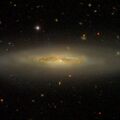Astronomy:NGC 4388
Coordinates: ![]() 12h 30m 31.113s, +41° 42′ 04.22″
12h 30m 31.113s, +41° 42′ 04.22″
| NGC 4388 | |
|---|---|
| File:NGC 4388 - HST - Potw1649a.tif Hubble Space Telescope image of NGC 4388 | |
| Observation data (J2000 epoch) | |
| Constellation | Virgo |
| Right ascension | 12h 25m 46.820s[1] |
| Declination | +12° 39′ 43.45″[1] |
| Redshift | 0.008419[2] |
| Helio radial velocity | 2,524[2] km/s |
| Distance | 56.7 Mly (17.4 Mpc)[3] |
| Group or cluster | Virgo Cluster[4] |
| Apparent magnitude (V) | 11.02[5] |
| Apparent magnitude (B) | 11.76[5] |
| Characteristics | |
| Type | SA(s)b[4] |
| Mass | 26.4+16.4 −10.1×109[3] M☉ |
| Size | 120 kly (36 kpc)[2] |
| Apparent size (V) | 6.2′ × 1.674′[2] |
| Other designations | |
| NGC 4388, UGC 7520, MCG+02-32-041, PGC 40581[5] | |
NGC 4388 is an active spiral galaxy in the equatorial constellation of Virgo. It was discovered April 17, 1784 by Wilhelm Herschel.[6] This galaxy is located at a distance of 57 million light years[3] and is receding with a radial velocity of 2,524km/s.[2] It is one of the brightest galaxies of the Virgo Cluster due to its luminous nucleus. NGC 4388 is located 1.3° to the west of the cluster center, which translates to a projected distance of ≈400 kpc.[4]
The NGC 4388 galaxy has been assigned a morphological class of SA(s)b, which indicates it is a spiral with no central bar (SA) or inner ring structure (s), and has moderately-wound spiral arms (b). It is inclined at an angle of 79° to the line of sight from the Earth and thus is being viewed from nearly edge-on. The major axis of the elliptical profile is aligned with a position angle of 92°.[4]
The interstellar medium of the galaxy has recently undergone a stripping event due to ram pressure, causing star formation to steeply decline some 190±30 Myr ago. The galaxy may have passed close to the cluster center around 200 Myr ago, which led to the loss of much of its neutral hydrogen from interaction with the inter-cluster medium.[4]
This is a classic Type 2 Seyfert galaxy where the emission from the active galactic nucleus is being concealed by a torus of obscuring gas and dust.[7] The supermassive black hole at the core has a mass of (8.5±0.2)×106 M☉, which has a hot corona with a temperature energy of 80+40
−20 keV that is producing X-ray emission.[8] There is a strong nuclear outflow to the north and south that extends out as far as 5 kpc from the core. These flows have a mean velocity of 270±70 km·s−1.[4]
One supernova has been observed in NGC 4388: SN 2023fyq (type Ib-pec, mag. 19.5 at discovery).[9]
Gallery
-
NGC 4388 (SDSS DR14)
-
NGC 4388 (HST)
References
- ↑ 1.0 1.1 Skrutskie, Michael F. et al. (1 February 2006). "The Two Micron All Sky Survey (2MASS)". The Astronomical Journal 131 (2): 1163–1183. doi:10.1086/498708. ISSN 0004-6256. Bibcode: 2006AJ....131.1163S.
- ↑ 2.0 2.1 2.2 2.3 2.4 "NASA/IPAC Extragalactic Database". Results for NGC 4388. http://ned.ipac.caltech.edu/cgi-bin/objsearch?objname=NGC+4388&extend=no&hconst=73&omegam=0.27&omegav=0.73&corr_z=1&out_csys=Equatorial&out_equinox=J2000.0&obj_sort=RA+or+Longitude&of=pre_text&zv_breaker=30000.0&list_limit=5&img_stamp=YES.
- ↑ 3.0 3.1 3.2 Lianou, S. et al. (November 2019). "Dust properties and star formation of approximately a thousand local galaxies". Astronomy & Astrophysics 631: 19. doi:10.1051/0004-6361/201834553. A38. Bibcode: 2019A&A...631A..38L.
- ↑ 4.0 4.1 4.2 4.3 4.4 4.5 Damas-Segovia, A. et al. (June 2016). "CHANG-ES. VII. Magnetic Outflows from the Virgo Cluster Galaxy NGC 4388". The Astrophysical Journal 824 (1): 11. doi:10.3847/0004-637X/824/1/30. 30. Bibcode: 2016ApJ...824...30D.
- ↑ 5.0 5.1 5.2 "NGC 4388". SIMBAD. Centre de données astronomiques de Strasbourg. http://simbad.u-strasbg.fr/simbad/sim-basic?Ident=NGC+4388.
- ↑ de Lazaro, Enrico (December 5, 2016). "Hubble Captures Spectacular Image of Spiral Galaxy NGC 4388". Sci News. http://www.sci-news.com/astronomy/hubble-image-spiral-galaxy-ngc-4388-04421.html.
- ↑ Elvis, Martin et al. (November 2004). "An Unveiling Event in the Type 2 Active Galactic Nucleus NGC 4388:A Challenge for a Parsec-Scale Absorber". The Astrophysical Journal 615 (1): L25–L28. doi:10.1086/424380. Bibcode: 2004ApJ...615L..25E.
- ↑ Ursini, F. et al. (September 2019). "The coronal temperature of NGC 4388 and NGC 2110 measured with INTEGRAL". Astronomy & Astrophysics 629: 9. doi:10.1051/0004-6361/201936273. A54. Bibcode: 2019A&A...629A..54U.
- ↑ Transient Name Server entry for SN 2023fyq. Retrieved 26 July 2023.
External links
 |



